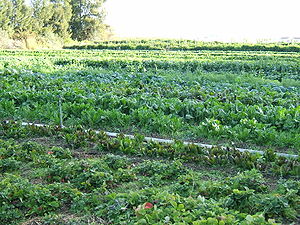
Organic farming is a form of agriculture which avoids or largely excludes the use of synthetic fertilizers and pesticides, plant growth regulators, and livestock feed additives. As far as possible, organic farmers rely on crop rotation, crop residues, animal manures and mechanical cultivation to maintain soil productivity and tilth to supply plant nutrients, and to control weeds, insects and other pests.
According to the international organic farming organization IFOAM : "The role of organic agriculture, whether in farming, processing, distribution, or consumption, is to sustain and enhance the health of ecosystems and organisms from the smallest in the soil to human beings." [3]
Approximately 31 million hectares (75 million acres) worldwide are now grown organically.
According to the international organic farming organization IFOAM : "The role of organic agriculture, whether in farming, processing, distribution, or consumption, is to sustain and enhance the health of ecosystems and organisms from the smallest in the soil to human beings." [3]
Approximately 31 million hectares (75 million acres) worldwide are now grown organically.
Overview
Wendell Berry, "The Gift of Good Land"
Organic farming excludes the use of certain synthetic inputs, such as synthetic fertilizers, pesticides, herbicides and genetically modified organisms (GMOs). In a number of countries, including the US, China[1] and most of Europe organic farming is also defined by law, so that the commercial use of the term organic to describe farming and food products is regulated by the government. Where laws exist, organic certification is available to farms for a fee, and it is usually illegal for a non-certified farm to call itself or its products organic. Elsewhere, for example, in Canada, voluntary certification is available, while legislation may be pending.
Methods of organic farming vary. However, organic approaches share common goals and practices. In addition to the exclusion of synthetic agrichemicals, these include protection of the soil (from erosion, nutrient depletion, structural breakdown), promotion of biodiversity (for example growing a variety of crops rather than a single crop or planting hedges around fields), and outdoor grazing for livestock and poultry, though none of these is required in the United States to earn the USDA organic seal[2][3] . Within this framework, individual farmers develop their own organic production systems, determined by factors such as climate, market conditions, and local agricultural regulations.
History
The organic movement began as a reaction of agricultural scientists and farmers against the industrialization of agriculture. Advances in biochemistry, (nitrogen fertilizer) and engineering (the internal combustion engine) in the early 20th century led to profound changes in farming. Research in plant breeding produced hybrid seeds. Fields grew in size and cropping became specialized to make efficient use of machinery and reap the benefits of the green revolution. Technological advances during World War II spurred on post-war innovation in all aspects of agriculture, resulting in such advances as large-scale irrigation, fertilization, and the use of pesticides. Ammonium nitrate, used in munitions, became an abundantly cheap source of nitrogen. DDT, originally developed by the military to control disease-carrying insects among troops, was applied to crops, launching the era of widespread pesticide use.
In Germany, Rudolf Steiner's Spiritual Foundations for the Renewal of Agriculture, published in 1924, led to the popularization of biodynamic agriculture.
The first use of the term organic farming is by Lord Northbourne. The term is derived from his concept of "the farm as organism" [5] and which he expounded in his book, Look to the Land (1940), wherein he described a holistic, ecologically balanced approach to farming.
The British botanist, Sir Albert Howard studied traditional farming practices in Bengal, India. He came to regard such practices as superior to modern agricultural science and recorded them in his 1940 book, An Agricultural Testament and adopted Northbourne's terminology in his book "The Soil and Health: A Study of Organic Agriculture" in 1947.
Lady Eve Balfour, author of the organics classic The Living Soil, established the pioneering Haughley Experiment on her Suffolk farm in 1939 that ran for more than 40 years.
In the US, J.I. Rodale popularized organic gardening among consumers during the 1940s.
The Japanese farmer and writer Masanobu Fukuoka invented a no-till system for small-scale grain production that he called Natural Farming. In the early 1940s.
In 1972, the International Federation of Organic Agriculture Movements (IFOAM), was founded in Versailles, France. IFOAM was dedicated to the diffusion of information on the principles and practices of organic agriculture across national and linguistic boundaries.
In the 1980s, various farming and consumer groups worldwide began pressing for government regulation of organic production. This led to legislation and certification standards being enacted beginning in the 1990s.
Since the early 1990s, the retail market for organic farming in developed economies has grown about 20 per cent annually due to increasing consumer demand. While small independent producers and consumers initially drove the rise of organic farming, meanwhile as the volume and variety of "organic" products grows, production is increasingly large-scale.

No comments:
Post a Comment